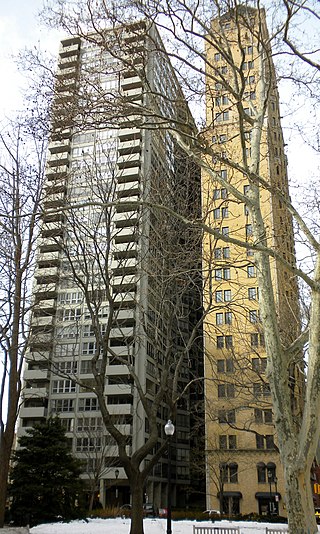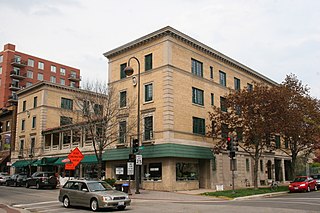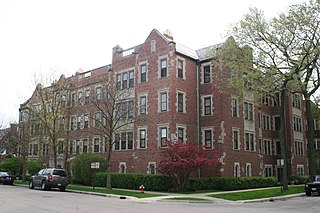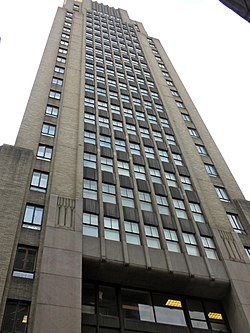
Rittenhouse Square is a public park in Center City Philadelphia, Pennsylvania that is the center of the eponymous Rittenhouse neighborhood. The square is one of the five original open-space parks planned by William Penn and his surveyor Thomas Holme during the late 17th century.

Walnut Street Theatre, founded in 1808 at 825 Walnut Street, on the corner of S. 9th Street in the Washington Square West neighborhood of Philadelphia, is the oldest operating theatre in the United States.

Walnut Hill is a neighborhood in the West Philadelphia section of Philadelphia, Pennsylvania, United States. It is located between 45th Street and 52nd Street, bounded by Market Street and Spruce Street. Most of the neighborhood is in the northwestern part of the University City District. It is located north of the neighborhoods of Garden Court and Spruce Hill.

The Franklin Residences is a historic apartment building located at 834 Chestnut Street in Center City, Philadelphia, Pennsylvania. It opened on January 14, 1925, as the Benjamin Franklin Hotel and was named after United States Founding Father Benjamin Franklin.

The St. James is a luxury residential skyscraper in Washington Square West, Philadelphia, Pennsylvania, United States. The 498 feet (152 m), 45-story high-rise stands along Walnut Street and Washington Square and is the 15th tallest building in Philadelphia.

West Philadelphia High School is a secondary school located in the West Philadelphia section of Philadelphia, Pennsylvania at the intersection of 49th Street and Chestnut Street.

The Alexandra is a historic apartment building located on Gilbert Avenue in the Walnut Hills neighborhood of Cincinnati, Ohio, United States. Constructed in 1904 as the neighborhood's first large apartment building, it was one of many such buildings constructed for the real estate management firm of Thomas J. Emery's Sons. It has been named a historic site.

The Saxony Apartment Building is a historic apartment building in Cincinnati, Ohio, United States. Located along Ninth Street in the city's downtown, this five-story brick building includes a distinctive range of architectural details. Among these elements are brick pilasters and projections, a three-story bay window on each side of the symmetrical main facade, semicircular balconies, and many stone pieces, such as pediments, keystones, and stringcourses. Due to its location at the intersection of Ninth and Race Streets, the Saxony appears to have two fronts: one onto each street. Although the Ninth Street facade is larger and more complex, the Race Street facade is nevertheless ornate as well: it features small yet elaborate semicircular balconies with wrought iron railings similar to those of the Ninth Street facade.

The Alameda Apartments is a historic apartment building at the northeast corner of 7th Street and Elberon Avenue in Zanesville, Ohio, United States. Built circa 1910, the building was one of many apartments constructed during Zanesville's industrial and population boom of the early twentieth century. While the architect of the Gothic Revival building is unknown, it was most likely designed by Zanesville architect Harry C. Meyer. The two-story brick building includes a storefront on one corner and first- and second-floor apartments in the rest of its space. Its design features a bell-shaped gable at one corner, two oriel windows topped by small gables, brick corbels throughout, and dormers and brick chimneys projecting from the roof.

The Carl Mackley Houses, also originally known as Juniata Park Housing, is a private apartment complex in the Juniata neighborhood of Philadelphia, Pennsylvania. Built in 1933–1934 as single-family apartments, it opened in 1935. The project was sponsored by the American Federation of Full Fashioned Hosiery Workers, with financing by the Housing Division of the Public Works Administration, of which it was the first funded project. The complex was named for a striking hosiery worker killed by non-union workers during the H.C. Aberle Company strike in 1930.

The Somerset Apartments was an apartment building located in Detroit, Michigan. It was also known as the Parkcrest Apartment Building. The building was listed on the National Register of Historic Places in 1985.

The Rossmore Apartment House is a demolished historic building in Downtown Louisville, Kentucky, United States.

Cast Iron House at the corner of Franklin Street and Broadway in the Tribeca neighborhood of Manhattan, New York City, formerly known as the James White Building, was built in 1881–82 and was designed by W. Wheeler Smith in the Italianate style. It features a cast-iron facade, and is a good example of late cast-iron architecture. The building was renovated by architect Joseph Pell Lombardi in 2000, and a restoration of the facade began in 2009. The building once housed the offices of Scientific American from 1884 to 1915, but it was primarily used in connection with the textile trade.

The Dorilton is a luxury residential housing cooperative at 171 West 71st Street, at the northeast corner with Broadway, on the Upper West Side of Manhattan in New York City. The 12-story building, designed by local firm Janes & Leo in the Beaux-Arts style, was built between 1900 and 1902 for real estate developer Hamilton M. Weed. The Dorilton is a New York City designated landmark and is listed on the National Register of Historic Places.

The Touraine is a historic building in Philadelphia, Pennsylvania. The 13-story building was originally constructed in 1917 as a grand hotel. In 1983, it was converted into luxury apartments.

The Chateau Crillon Apartment House, also known as the Cohen Apartment House and the Rittenhouse 222 Apartments, is a historic high-rise building in the fashionable Rittenhouse Square section of Philadelphia, Pennsylvania, United States.

Grace Hospital is an American historic hospital in Richmond, Virginia. The original Colonial Revival structure was built in 1911 based on a design by noted Virginia architect Charles M. Robinson. The hospital is located to the west of Richmond's central business district and was substantially expanded by additions in 1930 and 1964. The original three-story main structure with an entrance pavilion on West Grace Street, is a Colonial Revival building with paired Ionic order columns and gauged arches. In 1930, a five-story Moderne style addition was built to the south along Monroe Street. In 1964, a further three-story addition was built along Grace Street. The 1964 addition is devoid of ornamentation, and the west wing "projects a modern, utilitarian character."

Colonnade Court is a historic apartment building at the northwest corner of Main Street and Hinman Avenue in Evanston, Illinois. The four-story building was built in 1928–29. The building's first floor is used as commercial space, while the other three floors house apartments. Like many of Evanston's apartment buildings, the building has a "U" shape with a central courtyard; however, the courtyard is on the second floor to separate it from the commercial space. Architects Thielbar & Fugard designed the building to imitate an Italian Renaissance villa. The building's design includes a colonnade concealing its courtyard from the street, arched entrances, and a bracketed cornice.

The Building at 417–419 Lee Street is a historic apartment building in Evanston, Illinois. The two-story four-flat building was built in 1902. Architect Edgar O. Blake, an Evanston architect who had designed houses in the city since the 1870s, designed the building. The building's design includes a Georgian entrance with side columns, sidelights, and a fanlight, limestone banding, a wooden entablature, and a brick parapet. The four apartments are an early example of upper-class apartment design in Evanston; of particular note are its screened porches, which were a precursor to the sunrooms commonly seen in later buildings.

The Building at 999 Michigan, 200 Lee is a historic apartment building at the southeast corner of Michigan Avenue and Lee Street in Evanston, Illinois. The three-story brick building was built in 1927. Architects McNally and Quinn designed the Tudor Revival building. The building's design features arched entrances, projecting bays, limestone window moldings, decorative gargoyles, and a parapet with several gables. The Tudor design continues in the building's interior, which includes wood panels in its lobby, wrought iron balustrades on its staircases, and marble fireplaces in the apartments themselves.

























